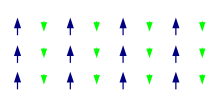
A | B | C | D | E | F | G | H | CH | I | J | K | L | M | N | O | P | Q | R | S | T | U | V | W | X | Y | Z | 0 | 1 | 2 | 3 | 4 | 5 | 6 | 7 | 8 | 9


A ferrimagnetic material is a material that has populations of atoms with opposing magnetic moments, as in antiferromagnetism, but these moments are unequal in magnitude, so a spontaneous magnetization remains.[1] This can for example occur when the populations consist of different atoms or ions (such as Fe2+ and Fe3+).
Like ferromagnetic substances, ferrimagnetic substances are attracted by magnets and can be magnetized to make permanent magnets. The oldest known magnetic substance, magnetite (Fe3O4), was classified as a ferromagnet before Louis Néel discovered ferrimagnetism in 1948.[2] Since the discovery, numerous uses have been found for ferrimagnetic materials, such as hard-drive platters and biomedical applications.
History
Until the twentieth century, all naturally occurring magnetic substances were called ferromagnets. In 1936, Louis Néel published a paper proposing the existence of a new form of cooperative magnetism he called antiferromagnetism.[3] While working with Mn2Sb, French physicist Charles Guillaud discovered that the current theories on magnetism were not adequate to explain the behavior of the material, and made a model to explain the behavior.[4] In 1948, Néel published a paper about a third type of cooperative magnetism, based on the assumptions in Guillaud's model. He called it ferrimagnetism. In 1970, Néel was awarded for his work in magnetism with the Nobel Prize in Physics.[5]
Physical origin

Ferrimagnetism has the same physical origins as ferromagnetism and antiferromagnetism. In ferrimagnetic materials the magnetization is also caused by a combination of dipole–dipole interactions and exchange interactions resulting from the Pauli exclusion principle. The main difference is that in ferrimagnetic materials there are different types of atoms in the material's unit cell. An example of this can be seen in the figure above. Here the atoms with a smaller magnetic moment point in the opposite direction of the larger moments. This arrangement is similar to that present in antiferromagnetic materials, but in ferrimagnetic materials the net moment is nonzero because the opposed moments differ in magnitude.
Ferrimagnets have a critical temperature above which they become paramagnetic just as ferromagnets do.[6] At this temperature (called the Curie temperature) there is a second-order phase transition,[7] and the system can no longer maintain a spontaneous magnetization. This is because at higher temperatures the thermal motion is strong enough that it exceeds the tendency of the dipoles to align.
Derivation
There are various ways to describe ferrimagnets, the simplest of which is with mean-field theory. In mean-field theory the field acting on the atoms can be written as
where is the applied magnetic field, and is field caused by the interactions between the atoms. The following assumption then is
Here is the average magnetization of the lattice, and is the molecular field coefficient. When we allow and to be position- and orientation-dependent, we can then write it in the form
where is the field acting on the i-th substructure, and is the molecular field coefficient between the i-th and k-th substructures. For a diatomic lattice we can designate two types of sites, a and b. We can designate the number of magnetic ions per unit volume, the fraction of the magnetic ions on the a sites, and the fraction on the b sites. This then gives
It can be shown that and that unless the structures are identical. favors a parallel alignment of and , while favors an anti-parallel alignment. For ferrimagnets, , so it will be convenient to take as a positive quantity and write the minus sign explicitly in front of it. For the total fields on a and b this then gives
Antropológia
Aplikované vedy
Bibliometria
Dejiny vedy
Encyklopédie
Filozofia vedy
Forenzné vedy
Humanitné vedy
Knižničná veda
Kryogenika
Kryptológia
Kulturológia
Literárna veda
Medzidisciplinárne oblasti
Metódy kvantitatívnej analýzy
Metavedy
Metodika
Text je dostupný za podmienok Creative
Commons Attribution/Share-Alike License 3.0 Unported; prípadne za ďalších
podmienok.
Podrobnejšie informácie nájdete na stránke Podmienky
použitia.
www.astronomia.sk | www.biologia.sk | www.botanika.sk | www.dejiny.sk | www.economy.sk | www.elektrotechnika.sk | www.estetika.sk | www.farmakologia.sk | www.filozofia.sk | Fyzika | www.futurologia.sk | www.genetika.sk | www.chemia.sk | www.lingvistika.sk | www.politologia.sk | www.psychologia.sk | www.sexuologia.sk | www.sociologia.sk | www.veda.sk I www.zoologia.sk





















